Background This blog series is focused on programmers, systems administrators, and application administrators that want to run Docker in production. The subject matter ranges from workflow and practical guidelines to security and best practices in manageability. A Practical Introduction to Docker Containers A Practical Introduction to the Docker Registry Server Core Builds in the
Running Docker in Production
